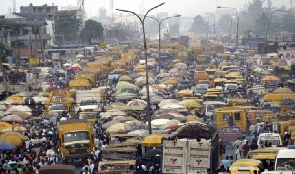 Fuel emissions from dirty fuels leads to air pollution in Africa
Fuel emissions from dirty fuels leads to air pollution in Africa
The World Health Organization estimates that 4.2 million deaths occur every year as a result of exposure to air pollution.
In West Africa, air pollution accounted for 80,000 premature deaths in 2017. The problem is grave in Nigeria, particularly in Lagos State, where 11,200 people died from air pollution in 2018, a study by the World Bank has said.
According to the study, children under five years are disproportionately affected by air pollution in Lagos, thus accounting for 60% of the deaths as they are easily susceptible to lower respiratory infection.
In monetary terms, the study noted that the loss of lives and productivity hours cost the city an estimated $2.1 billion or 2.1% of Lagos State’s Gross Domestic Product (GDP). Lagos is Nigeria’s largest commercial city. It is also one of the world’s fastest-growing megacities, expected to become the largest city by 2100.
Road transport, industrial emissions and power generation were the largest contributors to air pollution in Lagos, the study found. Lagos has limited transport options, forcing people to rely on personal vehicles, commercial cars or state transport services, motorcycles, tricycles and minibuses for transport. Commuters spend long hours in traffic congestion as a result of the poor road network, traffic management and driving habits, as well as lack of parking space.
The level of traffic congestion influences the degree of fuel consumption. This is also compounded by the old emission systems in most vehicles in Lagos and the importation of fuel with high sulfur content (dirty fuel).
Nigeria has unstable power spanning decades, thereby compelling citizens to rely on generators to power their homes and businesses. According to Access to Energy Institute (A2EI), Nigeria is home to some 23 million gasoline generators — eight times the national grid. At its peak, the available capacity of Nigeria’s grid is 5.4 GW, which is insufficient for current consumption needs, according to the publication. The toxic fumes released by the generators leads to illness and death. Also, a study by Carnegie Mellon University found that diesel generators in Nigeria produce carbon dioxide emissions equivalent to 60% of its annual electricity sector emissions.
At the heart of the pollution problem in Lagos is the lack of operational air quality monitoring stations in Lagos. Data on pollution in Lagos are largely based on short-term and irregular measurements, which means the actual scale of pollution in Lagos could be much worse than it is being reported.
The lack of real-time monitoring of air pollution is not only peculiar to Nigeria. In Africa, only seven have real-time air pollution monitors, according to a UNICEF report. The report also notes that an estimated 6 percent of children live near reliable, ground-level monitoring stations that provide real-time data on the quality of the air they are breathing. By contrast, about 72 percent of children live near reliable monitoring stations across Europe and North America.
To deal with the challenge of air pollution in Lagos, the study called for measures to reduce emissions such as incentives for purchasing cleaner passenger vehicles, vehicle inspections, retrofitting the most polluting vehicles, implementation of best available technologies in the most polluting industries, and use of solar cells with battery storage for power generation.